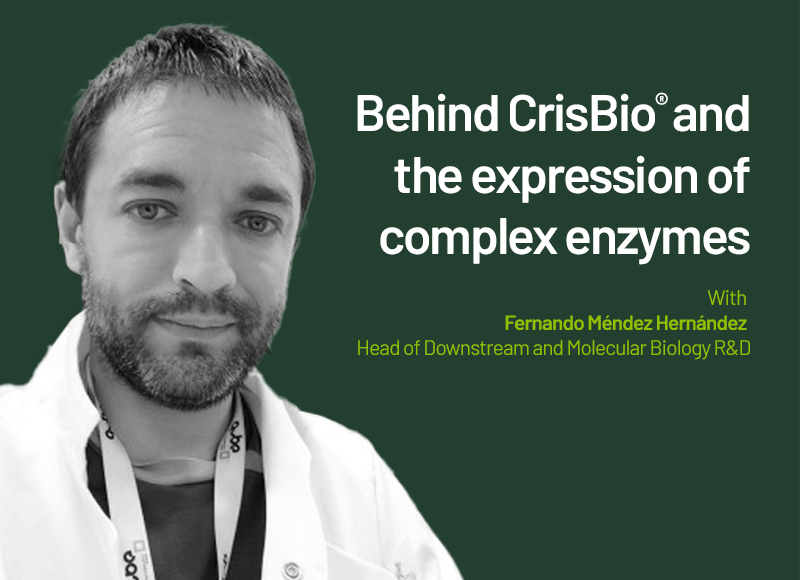25 November 2024
Behind CrisBio® and the expression of complex enzymes

The CrisBio® platform makes the ‘impossible’, possible. Over several decades, an incredible team has leveraged the power of nature to overcome common challenges in expressing complex enzymes. Now, our Derio facility is even supporting the production of growth factors and enzymes at industrial scale.
In light of this, we wanted to revisit the science (and the scientists) that are driving this innovation. In this blog, we hear from our Head of Downstream and Molecular Biology R&D, Fernando Méndez Hernández, as he discusses why CrisBio® is optimized for success with complex enzymes, and the challenges it solves.
Why do traditional expression systems often fail to express complex enzymes?
“Each type of cell has a specific way of performing post-translational modifications and, for some proteins, these are important for correct folding and functional activity. It happens that in bacteria and yeast, these modifications are often too different to those performed by mammal cells to be able to synthesize functional proteins.
In contrast, insect cells happen to have the most similar post-translational modification processes to those from mammal cells. Systems based on these types of cells are more versatile for protein expression as a result.
In some cases, certain proteins are even toxic to certain types of cells, making it impossible to be expressed in them. Having a multicellular system gives more chances to these proteins. If one type of cell cannot express, there will be other kinds of cells where there might be a success.”
Are there other solutions available?
“No system is universal. Different expression systems co-exist as each of them is suited to some group of proteins. For instance, monoclonal antibodies are very well expressed in mammalian cell systems. No other system can beat this. Any protein that can be simply produced in E.coli should be expressed very successfully in this system.
Other alternatives are needed for difficult-to-produce proteins, or those with a complex structure.”
How does CrisBio® support these difficult-to-produce proteins, and what led Cocoon Bioscience (spun-off from Algenex) to this solution?
“The BEVs already have quite a few advantages when compared to other fermentation-based systems; it has short development times, is very secure (as the baculovirus cannot infect mammalian cells), and is very versatile as post-translational modifications are often similar to those of mammalian cells.
But this system still has challenges such as scalability, complexity and high production costs in some cases. For this reason, Algenex had the idea to leverage nature; a concept which Cocoon Bioscience has now optimized and industrialized. This process involves inoculating a living insect with the recombinant baculovirus instead of having to control multiple factors to create the right environment for cultivated cells. In short, we discovered that the whole insect is the ideal bioreactor.”
How has Cocoon Bioscience optimized this approach?
“The main R&D challenges of CrisBio®´s industrialization were mainly developing the right insect rearing devices and diet formula. We needed to be able to rear the insects in a synchronized way, at an industrial scale, where all individuals reach the chrysalises stage at the same time, making the automation of the process possible.
Insects are, of course, composed of insect cells; thus, their post-translational modifications closely resemble those performed by mammalian cells. We also then set the conditions for successful expression.
The Upstream (US) process is defined per protein. For each protein there is a specific combination of three parameters (virus dose, time of incubation and temperature of incubation) where the peak of productivity is found.”
RELATED: Overcoming the core challenges of recombinant protein production
What is unique about the CrisBio® downstream process?
“The Downstream (DS) depends on the nature of each specific protein, and therefore, when using CrisBio®, a conventional DS is applied. It’s basically the same as if the protein had been expressed in cultivated insect cells, apart from the first step.
When purifying a protein from a tissue culture you start with a liquid extract, the culture supernatant. With CrisBio® you start with a solid biomass; the chrysalises containing the expressed recombinant protein. Therefore, the first step consists of crushing the chrysalises in the desired buffer by using a conventional mill, then the hard cuticle bits are removed by gross filtration. The result is a liquid extract that can face a conventional DS with centrifugations, depth filtrations, chromatography and TFF.
Although the DS in CrisBio® is very similar to that used for tissue cultures, there is one important difference. That is, the volumes needed to be manipulated are much lower, as everything happens in a much more concentrated environment. This is translated directly into cost-efficiency and reduction of production times.”
Read more about how Cocoon enzures quality, functionality and performance
What other aspects of CrisBio® make it suited for expressing complex enzymes?
“Our system not only allows the expression of one protein at a time, but we can also express several simultaneously. In certain situations, this allows us to express our protein of interest, and simultaneously, a secondary protein that can help with the correct folding or processing of the main protein. This greatly helps to achieve the expression of complex proteins, which would not be possible otherwise.”
To learn more about our CrisBio® platform, visit our technology page or get in touch with us at info@cocoonbio.com.



